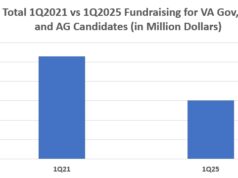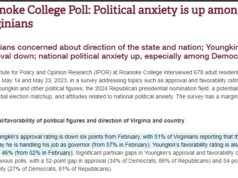There hasn’t been any public polling so far for the 2021 Virginia governor’s race, but today I got the “topline numbers” from an “internal” poll by the Jennifer McClellan for governor campaign. The numbers from the poll – which was conducted by McClellan’s pollster, Pete Brodnitz (who is very well respected; has worked with Tim Kaine, Jim Webb, etc, etc.) are as follows. Also, I had a chance to chat with Pete Brodnitz, who gave me more detail on the poll and talked through it with me. Highlights from that are below, along with a few of my thoughts. But first, here are the topline preferences among likely Democratic primary voters:
- Former Gov. Terry McAuliffe 32%
- Lt. Gov. Justin Fairfax 16%
- State Senator Jennifer McClellan 8%
- Delegate Jennifer Carroll Foy 5%
- Undecided 38%
I have a few thoughts on these numbers, but first, here are some highlights from my conversation with Pete Brodnitz:
- Brodnitz – “For me, the main thing is that you have such a big undecided – there are more people undecided than who are selecting Terry – despite the fact that he’s universally known.”
- Brodnitz – McAuliffe has a name ID advantage, but “McClellan is positioned really well.”
- Brodnitz – “Clearly, experience matters…in a Democratic primary because we actually care about governance.” Brodnitz added that McClellan has “more experience than the entire rest of the field combined” and that McClellan has done a lot of work “in the kinds of issues that people care about,” such as education – which McClellan has been working on in the legislature, while McAuliffe “has been in office for four years and yet he’s going to her legislative record for the ‘big ideas’.”
- Brodnitz asked in his polling whether Democratic voters preferred electing one of the women running “since Virginia could benefit from the new point of view they would bring to the office when it comes to issues like the impact COVID-19 is having on families and the way the economy is impacting women in particular” or “electing Terry McAuliffe since, as the former governor, he has the experience needed to hit the ground running during a challenging time for Virginia.” According to Brodnitz, by a 63%-29% margin, the primary electorate said “we benefit more from having the new perspective that one of the women would bring.”
- Brodnitz said he thought it was interesting that when McAuliffe launched, he didn’t launch as the “jobs candidate,” but more as the “education candidate.” Brodnitz believes McAuliffe might have done that because today, there’s a different set of issues than in the past, and today, most Democratic primary voters say they’re concerned with education and health care.
- According to Brodnitz, both Carroll Foy and McClellan are starting off with relatively low name ID, and that translates into lower support, while McAuliffe “is very well known.”
- Brodnitz said they gave positive paragraphs for each of the four candidates, and then retested ballot support, and “McClellan gained the most” from the baseline. According to Brodnitz, “Foy gained but less than McClellan,” while Fairfax “lost some support.”
- According to Brodnitz, McClellan has “a geographic base,” while Carroll Foy “really doesn’t…in Prince William, she actually has less of a base, which I will say is, I believe, the reason why she is constantly mentioning that she was born in Petersburg, which she does not represent; she does not mention Prince William nearly as much as where she was born.”
- Brodnitz said that right now, “the men are competing more for men and the women are competing more for women…in both cases, they have a stronger appeal with their own gender.” As for ideology, Brodnitz said “it’s not that ideological at this point, even though…we’ve got candidates who have very different points of view on things.”
Finally, here are few things that jumped out at me from the polling:
- The fairly high percentage of “undecideds,” at 38%, is interesting, even though McAuliffe was governor for four years, Fairfax has been Lt. Governor for three years, etc.
- As Brodnitz confirmed, the candidate preference percentages correlated pretty well with the candidates’ “name ID,” with McAuliffe presumably having by far the highest in that regard, followed by Fairfax. Clearly, McClellan and Carroll Foy are going to have to spend significant resources communicating with voters in order to raise their name IDs. That, of course, will require money, and lots of it, so we’ll see what the campaign finance numbers look like when they come out in mid-January 2021. Also note that rumors are floating around that Jennifer Carroll Foy will be reporting a VERY large number – upwards of $4 million (I’m not sure if that’s cash on hand or the amount raised in the 2nd half of 2020) in January. If true, that will certainly give Carroll Foy some serious resources to start communicating with voters!
- McAuliffe starts off in decent shape, although certainly not running away with it by any means. One question is where those undecideds end up going, and whether McAuliffe can win a good chunk of them. Remember that there’s no “ranked choice voting” in statewide primaries, which means that it’s “first past the post” – whichever candidate gets the most votes wins, period, even if it’s well less than 50%. It’s worth noting that in October 2017, as McAuliffe’s governorship was winding down, a Quinnipiac poll found him holding an 88%-6% approval rating among Virginia Democrats. We’ll see if that carries over to the 2021 Democratic gubernatorial primary…or not so much.
- The big questions in my mind for Lt. Gov. Fairfax are whether he can grow his support, and also whether he can raise large amounts of money for his campaign. Or, could Fairfax not raise much money and end up falling back in the pack, and if so, which rival candidates would those Fairfax supporters end up gravitating towards?
- This comment by Brodnitz could really prove crucial: “by a 63%-29% margin, the primary electorate said that they ‘benefit more from having the new perspective that one of the women would bring.'”
- We’ll see if this primary remains non-ideological, as Brodnitz said that it is right now. We’ll also see whether/to what extent McClellan’s “geographic base” in central Virginia helps her. And we’ll see how much each candidate gains – or loses – as voters get to know more about them…which, after all, is what primaries are supposed to be about. So stay tuned!
















